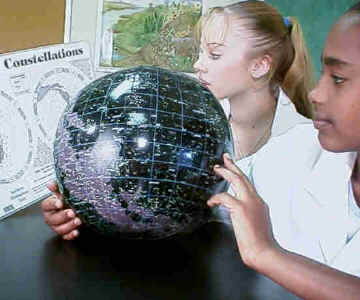| On this celestial globe
the equator is 0º. This does not correspond to the Earth’s equator,
so it is called the celestial equator. From the celestial
equator parallel lines are spaced north and south. These are
the parallels of declination, which indicate the distance of a star
from the celestial equator measured in degrees. If a star is north of
the celestial equator it is written as +, at the celestial equator it
is 0, and south of the equator it is written -.
The 0 hour line of right ascension
is the point where the Sun crosses the celestial equator on its way
north each year. This point defines a half circle from the north to
the south celestial pole called the celestial prime meridian.
Each successive line increases 1 hour, for a total of 24 hours.
However, line 24 h is the same as 0h.
The celestial globe is also divided
into 88 constellations to help locate different regions in the
Universe.
There are symbols throughout the
globe to help you identify the nighttime sky. See if you can figure
them out before you look at the legend.
|

|